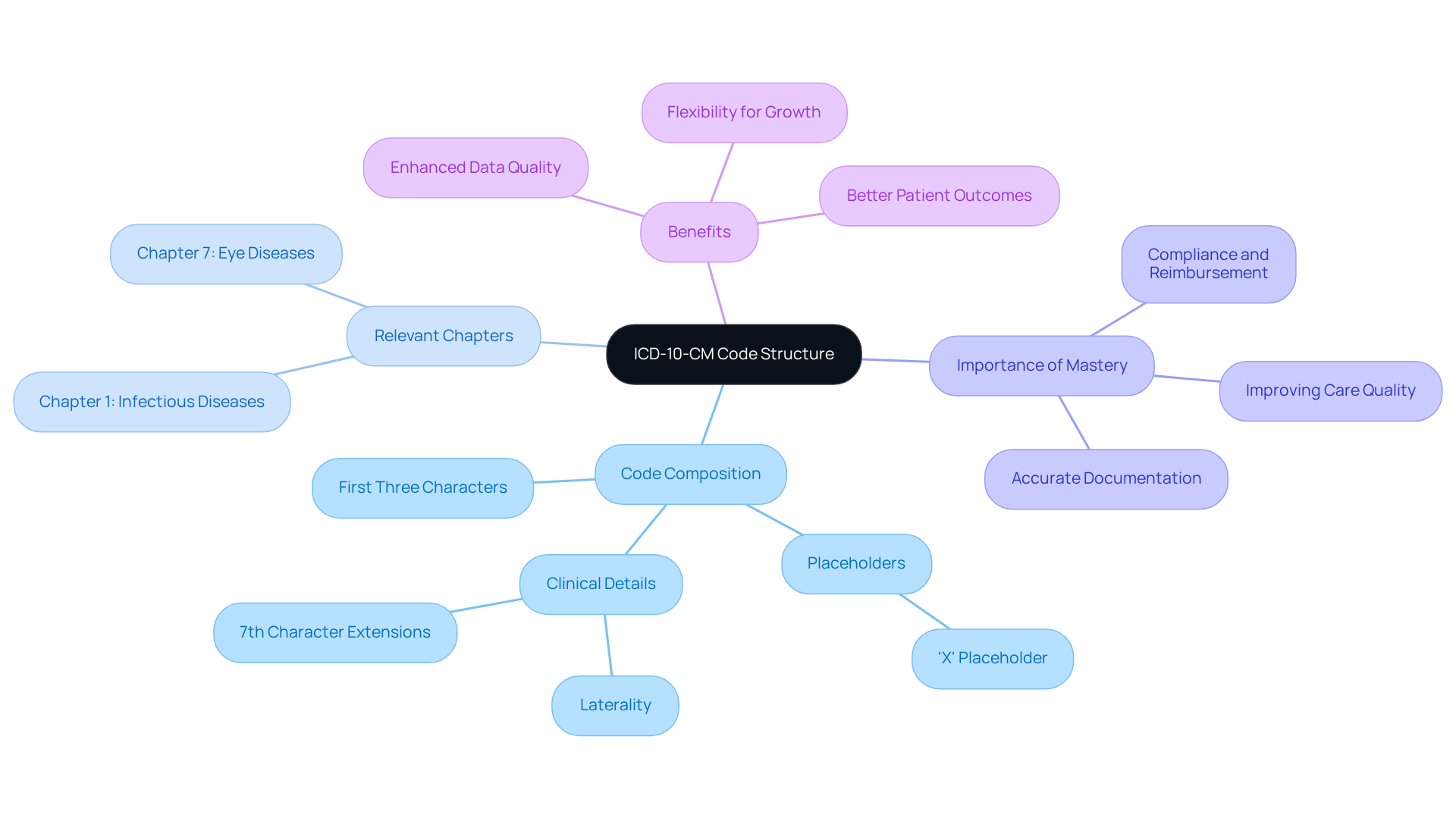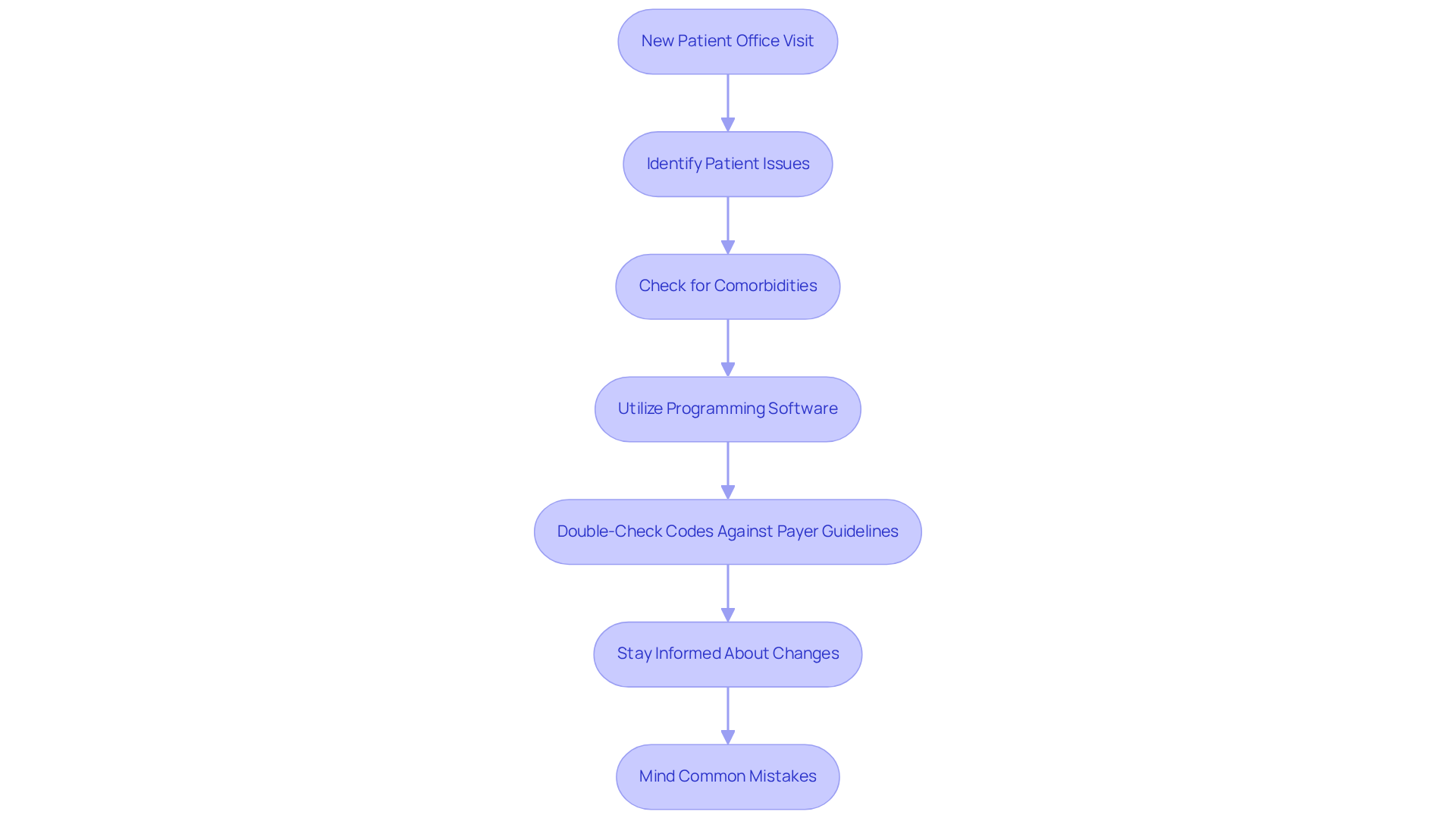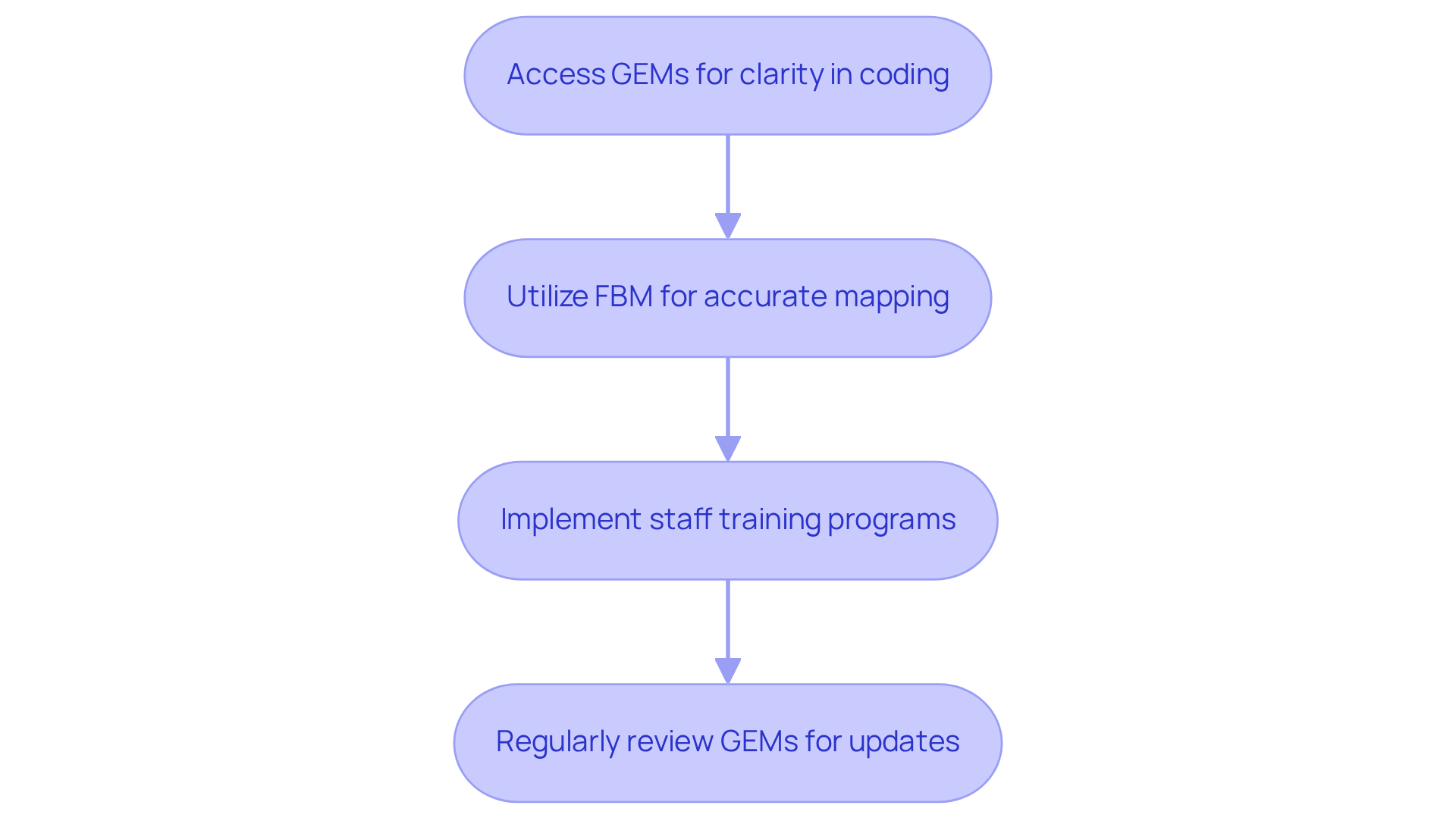Overview
In the demanding world of healthcare, providers often face emotional challenges that can weigh heavily on their ability to deliver quality patient care. The administrative burdens, particularly around coding and billing, can feel overwhelming. How can you ensure that your focus remains on your patients while navigating these complexities?
Understanding the essential ICD-10 codes for new patient office visits is crucial. Mastering these codes not only aids in accurate documentation but also streamlines the billing process. By utilizing resources like General Equivalence Mappings (GEMs) and advanced programming software, you can alleviate some of this burden. These tools are designed to support you in achieving compliance and optimizing reimbursement, ultimately enhancing the quality of care you provide.
Consider these key solutions:
- Familiarize yourself with the essential ICD-10 codes.
- Leverage GEMs for better coding accuracy.
- Invest in advanced programming software to simplify your processes.
By embracing these strategies, you can transform the way you manage coding and billing. This not only benefits your practice but also allows you to dedicate more time to what truly matters—your patients. Remember, you’re not alone in this journey. Together, we can navigate these challenges and improve the healthcare experience for everyone involved.
Are you ready to take the next step? Engage with your resources and reach out for support. Your commitment to mastering these codes will not only enhance your practice but also uplift the quality of care you provide.
Introduction
Navigating the complex world of medical coding can feel overwhelming, especially with the shift from ICD-9-CM to ICD-10-CM. This transition brings not only a significantly larger code set but also a heightened need for accurate documentation in patient care. Many healthcare providers may feel the weight of these changes, as administrative burdens can impact their ability to focus on what truly matters: their patients.
This article explores essential ICD-10 codes for new patient office visits, offering valuable insights and strategies to enhance coding practices. By understanding these codes, healthcare professionals can improve their documentation, ensuring compliance and accuracy while minimizing the risk of claim denials.
As the complexities of coding evolve, how can you ensure that your documentation meets the new standards? Here are some key solutions to consider:
- Embrace ongoing education: Stay updated on coding changes and best practices.
- Utilize coding resources: Leverage tools and guides that simplify the coding process.
- Foster collaboration: Work closely with your team to share knowledge and strategies.
By taking these steps, you can navigate the challenges of coding with confidence. Remember, you’re not alone in this journey. Together, we can enhance patient care while ensuring that your coding practices are both accurate and efficient.
Understand ICD-9-CM and ICD-10-CM Coding Systems
-
Have you ever felt overwhelmed by the complexities of medical coding? Understanding the history and purpose of ICD-9-CM and ICD-10-CM can help ease some of that burden. ICD-9-CM was established as the standard classification system for electronic data interchange in 2000, while ICD-10-CM was implemented on October 1, 2015, to keep pace with advancements in medical science and technology.
-
It’s important to recognize the distinctions between these two systems. ICD-10-CM offers heightened specificity, providing over 68,000 diagnosis identifiers compared to around 14,000 in ICD-9-CM. This expanded code set allows for more detailed classifications, including laterality and severity, which are crucial for accurate documentation and billing. Imagine how much easier it could be to ensure precise patient records with this level of detail.
-
As you navigate this transition, consider reviewing resources or training materials that explain the shift from ICD-9 to ICD-10. This change has shown to improve the accuracy of patient records and streamline the billing process. However, it’s also important to acknowledge the challenges, such as the steep learning curve for healthcare providers. How can we support each other through this adjustment?
-
To facilitate a smooth transition, ensure that all personnel involved in programming are well-trained on both systems. Thorough training is essential to manage the complexities of ICD-10-CM, which presents a five-fold increase in intricacy. This adjustment requires healthcare providers to adapt to a new terminology for classification. Together, we can navigate these changes and enhance our patient care.

Review ICD-10-CM Code Structure
Understanding the ICD 10 code for new patient office visit classification framework is crucial for accurate documentation during initial patient visits. Have you ever felt overwhelmed by the complexities of coding? Each identifier starts with a letter, followed by numbers, and may include placeholders like 'X' for future expansion. The first three characters indicate the diagnosis category, while the following characters provide additional clinical details, such as laterality and severity. As Donna J. Cartwright, Senior Director of Strategic Reimbursement, points out, "The new ICD-10-CM system is growing to approximately 68,000 entries and offers flexibility for growth." This highlights the importance of mastering this classification system.
To ease your journey, familiarize yourself with relevant chapters for new patient visits, such as:
- Chapter 1: Certain Infectious and Parasitic Diseases
- Chapter 7: Diseases of the Eye and Adnexa
Using coding manuals or software with visual aids can significantly enhance your understanding of code organization. Participating in practice programming examples will strengthen your ability to navigate the ICD-10-CM structure effectively. This ensures you apply the correct codes for accurate documentation and billing.
As programming experts emphasize, mastering the intricacies of ICD-10 is vital for improving care quality and optimizing healthcare delivery. Precise documentation not only supports compliance and reimbursement but also enhances the overall quality of healthcare data. The transition from ICD-9 to ICD-10 underscores the importance of grasping these new classification standards, as they provide a more detailed and specific framework for recording individual information.
By embracing these changes, you can alleviate some of the administrative burdens that impact patient care. Let's work together to ensure that you feel confident in navigating this essential system.

Apply Accurate Codes for New Patient Office Visits
-
Have you ever felt overwhelmed by the complexities of coding during new patient visits? It’s a common challenge that many healthcare providers face. Determining the appropriate ICD 10 code for new patient office visit classifications based on a patient’s presenting issues and medical history is crucial. This not only ensures accurate documentation but also reflects the intricacy of each visit, allowing you to provide the best care possible.
-
It’s essential to consider any comorbidities or additional factors that might affect a patient’s care. Capturing the full scope of the visit is vital for appropriate reimbursement and for ensuring that every aspect of the patient’s health is addressed.
-
Utilizing advanced programming software can significantly enhance your accuracy during new patient visits. These tools often come with features like automated programming suggestions and real-time script verification, which can help reduce mistakes and ensure compliance with payer guidelines.
-
Remember to double-check your selected codes against payer guidelines. Compliance is key to avoiding claim denials, which can be frustrating. Did you know that over 30% of claims are rejected due to inaccurate documentation? This can lead to substantial revenue loss, something no practice can afford.
-
Staying informed about programming changes and updates is crucial. This knowledge helps prevent revenue loss from claim denials and keeps your medical records and billing methods precise. Regularly reviewing programming updates can make a significant difference in your practice.
-
Be mindful of common programming mistakes during new client appointments. Misclassifying the complexity of a visit or overlooking comorbidities can hinder coding accuracy. By understanding these pitfalls, you can improve your coding practices and enhance overall efficiency in your practice.
-
As Dr. Samuel L. Church wisely states, "Getting into the mindset that everything you do for that patient on that day 'counts' will make you better prepared to document using time, and more diligent about tracking those minutes."
Looking ahead, be prepared for the upcoming modifications to the ICD 10 code for new patient office visit classifications in 2025. These changes will address new healthcare demands and therapies, ensuring your operations remain effective and minimizing claim denials.
- By embracing these strategies, you can navigate the complexities of coding with confidence and compassion, ultimately enhancing the care you provide to your patients.

Utilize General Equivalence Mappings for Transition
-
Are you feeling overwhelmed by the transition from ICD-9 to ICD-10? You're not alone. Accessing the General Equivalence Mappings (GEMs) provided by the Centers for Medicare & Medicaid Services (CMS) can help clarify the relationships between these coding systems. This is crucial for precise classification during this challenging time. As noted by Boyd et al., many ICD-9-CM to ICD-10-CM translations are complex, making GEMs essential for navigating these hurdles.
-
By utilizing GEMs, you can identify the ICD 10 code for new patient office visit, ensuring that all relevant diagnoses are captured and none are overlooked. The Forward Backward Map (FBM) has shown high precision and recall rates, proving its effectiveness in maintaining accuracy. This can significantly ease the burden on your team.
-
Consider implementing training programs for your staff on effectively using GEMs in their programming practices. This is vital for maintaining accuracy and compliance during this transition. Consistent training can help reduce the strain of manual evaluations. As highlighted by the writers, human verification is crucial in the development process, and your team deserves the support to navigate these changes confidently.
-
Regularly reviewing GEMs for updates or changes is essential, as staying informed is key to accurate documentation and billing. With new ICD-10-CM codes coming into effect on October 1, 2025, it's important for healthcare providers to be aware of these updates. This awareness will ensure compliance and accuracy in your coding practices, ultimately benefiting your patients.
Key Solutions:
- Access GEMs for clarity in coding.
- Utilize FBM for accurate mapping.
- Implement staff training programs.
- Regularly review GEMs for updates.
By taking these steps, you can alleviate some of the administrative burdens and focus more on what truly matters—providing excellent patient care.

Conclusion
Understanding and accurately applying ICD-10 codes for new patient office visits can feel overwhelming for healthcare providers. The shift from ICD-9-CM to ICD-10-CM brings not just a change in codes but also a need for deeper understanding and adaptation. This detailed coding system, with over 68,000 diagnosis identifiers, allows providers to capture the nuances of patient care, ensuring that all relevant information is recorded accurately.
Have you ever felt the weight of administrative burdens impacting your ability to provide quality care? It’s a common challenge in the healthcare field. That’s why thorough training on the ICD-10 coding structure is essential. Utilizing advanced programming tools and implementing General Equivalence Mappings (GEMs) can make this transition smoother. By grasping the code structure and recognizing the significance of each character, you can enhance your coding accuracy and compliance.
As we look ahead to the changes coming in 2025, continuous education and adaptation become even more vital. Embracing these strategies not only alleviates administrative burdens but also enhances the quality of patient care. By committing to ongoing learning and utilizing available resources, you can navigate the intricacies of ICD-10 coding with confidence.
Key Solutions to Consider:
- Engage in regular training sessions on ICD-10 coding.
- Leverage advanced programming tools to streamline processes.
- Stay informed about updates and changes in coding practices.
By doing so, you ensure that you deliver the best possible care while maintaining accurate and compliant documentation. Remember, you’re not alone in this journey; together, we can navigate these complexities and focus on what truly matters—providing exceptional care to our patients.




